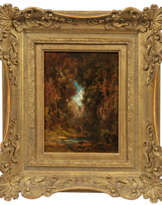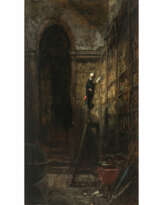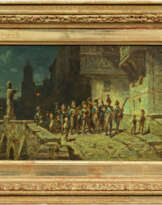ID 1465129
Lot 1800 | Carl Spitzweg (1808 München - 1885 ebenda)
Estimate value
€ 33 000 – 66 000
"Hirtenknabe (Italienische Landschaft - Zwei Hirtenknaben in einer romantischen Schlucht)". Originaltitel (nach Wichmann)
In dem um 1870 als kleines Hochformat angelegtes Kabinettbild, gibt Spitzweg eine pittoreske Felsschlucht mit reißendem, talabwärts stürzendem Gebirgsbach wieder - ein Motiv, das den Künstler besonders faszinierte. Auf einem Felsvorsprung, von dem ein umgestürzter Baumstamm über den Fluss führt, sitzt eine Hirtin und ein Hirte, der die Schalmei spielt. Überragt werden sie von einer oberhalb mit Laubbäumen bewaldeten Steilwand mit schmalem Treppenpfad. Die Schlucht gibt den Blick auf eine befestigte Burganlage mit Brücke frei, die von einer steil aufsteigenden Hochgebirgsfelswand rechts außen überragt wird. In pastos gesetzten Pinselstrichen und skizzenhafter Manier unmittelbar geschilderte Momentaufnahme, die in der Betonung der Gesamtstimmung und dem lichterfüllten Farbeinsatz exemplarisch im Spätwerk des Künstlers zu finden ist. Finanziell nach einer Erbschaft abgesichert, wendet sich Spitzweg, der eigentlich die Apothekerlaufbahn einschlagen sollte, in den 1830er Jahren der Malerei zu und unternahm schon früh ausgedehnte Reisen ins Münchener Umland und die gesamte Alpenregion. Begleitet wurde er dabei zumeist von seinem Malerkollegen und engem Vertrauten, dem Landschaftsmaler Eduard Schleich d. Ä. So auch auf einer künstlerisch äußerst prägenden Reise nach Paris, im Zuge dessen die beiden Freunde auch die südlich von Paris gelegene Künstlerkolonie Barbizon besuchten. Die dort ansässigen Künstler pflegten eine realistische, auf Beobachtung beruhende Naturauffassung, die sie, gefiltert durch den subjektiven Blick des Malers, in ihren "Paysages intimes" lichtdurchflutet und koloristisch befreit wiedergaben. Unter diesem Einfluss wurde Spitzwegs Malerei im Laufe der Zeit immer offener und lichterfüllter, und er fand zu eigenen, fortschrittlichen, dem Impressionismus den Weg ebnenden Tendenzen, die auch in dem vorliegenden Werk deutlich zu Tage treten. Öl/Mahagonitafel. R. u. monogr. (S in Rhombus; undeutlich).Verso Papieretikett "No. 24 C. Spitzweg". 20,8 cm x 8,3 cm.
Beiliegend handschriftliches Gutachten von Prof. Dr. Hermann Uhde-Bernays (vgl. Wichmann, S. 83 und 87), Starnberg 1930.
Wir danken Herrn Detlef Rosenberger, Oberostendorf, für die freundlichen Informationen. Das Werk wird von ihm in das digitale Werkverzeichnis der Gemälde Spitzwegs aufgenommen.
Aufgeführt in den Werkverzeichnissen von Siegfried Wichmann: "Carl Spitzweg. Verzeichnis der Werke (...)", Stuttgart 2002, Nr. 1407 (mit Abb.) und Günther Roennefahrt: "Carl Spitzweg. Beschreibendes Verzeichnis seiner Gemälde, Ölstudien und Aquarelle", München 1960, Nr. 619 (mit Abb.).
Provenienz: Im Juni 1931 in Berliner Privatbesitz, vorher im westdeutschen Kunsthandel mit dem Titel "Italienische Landschaft"; Auktion Lepke, Berlin 23./24.4.1936, aus Berliner Besitz, mit dem Titel "Zwei Hirtenknaben in einer romantischen Schlucht", Lot 420, Abb. Taf. 15; Norddeutsche Privatsammlung (auf der Auktion bei Lepke erworben).
Oil on mahogany panel. Monogrammed in red (indistinctly). Inscribed on an old label on the reverse. Mentioned in the catalogue raisonné by Siegfried Wichmann (no. 1407) and Günther Roennefahrt (no. 619).
| Artist: | Carl Spitzweg (1808 - 1885) |
|---|---|
| Auction house category: | Paintings |
| Artist: | Carl Spitzweg (1808 - 1885) |
|---|---|
| Auction house category: | Paintings |
| Address of auction |
Kunstauktionshaus Schloss Ahlden GmbH Große Str. 1 29691 Ahlden(Aller) Germany | ||||||||||||||
|---|---|---|---|---|---|---|---|---|---|---|---|---|---|---|---|
| Preview | |||||||||||||||
| Phone | +49 5164 80100 | ||||||||||||||
| Buyer Premium | 25.0 | ||||||||||||||
| Conditions of purchase | Conditions of purchase | ||||||||||||||
| Business hours | Business hours
|












